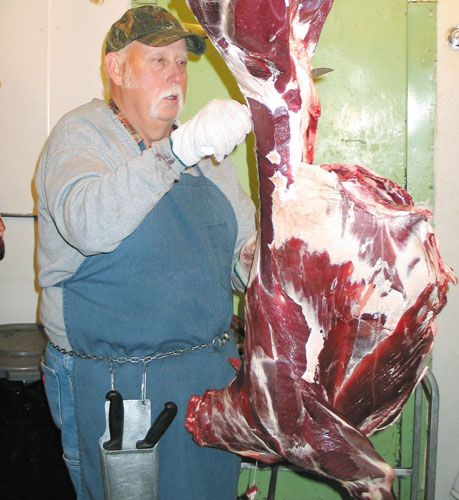Big game carcass care – Local butchers give advice
Published 8:33 pm Friday, October 7, 2011

- Jim Twisselman cuts deer meat at Union Market Tuesday. DICK MASON / The Observer
UNION – Hunters can be a paradoxical lot.
Many hunters spend months preparing for deer and elk seasons and then
days or weeks suffering through uncomfortable conditions before
harvesting their animal. Then they curiously neglect taking a few simple
steps to preserve the meat.
Few people understand this better than Jim Twisselman, a butcher for Union Market. Twisselman processes dozens of deer and elk plus an occasional moose and bear each year. Twisselman, who has worked at Union Market as a butcher for 12 years, speaks as if he enjoys his job.
What he is not crazy about are the hunters who do not bother to properly clean and cool their carcasses in the hours immediately after taking a big game animal. This ruins the quality of meat, causing it to harden and spoil.
Both issues can be addressed with the help of water, Twisselman said. The meat cutter urges hunters to rinse the big game meat with water after taking the hide off their animals. This washes off hair and dirt and helps cool the carcass.
Removing hair and dirt quickly is important because if it is not taken off right away it will become imbedded in the meat.
“Meat that is not washed when it is fresh has to be cut off,” Twisselman said.
The cooling effect water has can not be underestimated for lowering the temperature of a carcass plays a major role in preserving it. Washing the carcass with water does not have to be complicated.
“A garden hose works well,” Twisselman said.
Curiously, a number of hunters refuse to use water to clean their carcasses, mistakenly thinking it will hurt them.
“It is an a old wives’ tale. They don’t believe in doing it,” Twisselman said.
Game meat processor Troy Berglund of Joseph, like Twisselman, also emphasizes the importance of cooling a carcass as quickly as possible. He urges hunters to take the hide off their animals very soon after harvesting them to speed the temperature-lowering process.
Next, hunters should get the internal body cavity as clean as possible. Leaving even a little blood in the cavity is asking for trouble since bacteria grows in blood.
“It (leaving blood in the animal) gives bacteria a chance to party,” said Berglund, the owner of Mount Joseph Family Foods in Joseph, which processes game meat.
After cleaning their carcasses, hunters should get their animal to a refrigeration unit as soon as possible. This is particularly important when the weather is hot. Berglund noted that during the recent bow season, in which temperatures reached the 90s, hunters would leave their deer or elk hanging in camp a day or two before bringing them to be refrigerated.
“That was so wrong,” Berglund said.
Berglund noted that the Department of Agriculture requires the carcass of a hog to be cooled to 40 degrees within 24 hours after being harvested. He thinks that game hunters should strive to hit that standard.
Twisselman said he has encountered a number of hunters who did not cool their meat, causing it to spoil by the time they brought it in. Determining whether meat has spoiled is easy.
“Once you have smelled it you will never forget it,” Twisselman said.
So bad is the stench that the staff at Union Market will not allow a spoiled carcass to even be hung in its cooler.
“The smell coming off it would get into the fat,” Twisselman said.
Preventing spoilage of elk meat is more difficult than it is for deer meat because elk are bigger.
“Lowering the temperature of an an elk is harder (than it is for a deer) because it has more body mass,” Twisselman said.
Most of the big game animals processed at Union Market and Mount Joseph Family Foods are deer and elk. But hunters do bring in other animals including cougars and bears. Union Market has processed about 110 big game animals since bow season started in late August, said Mike Colkitt, the owner of Union Market. Mount Joseph Family Food processes between 200 and 250 game animals a year.
Berglund said the deer and elk he has processed this year appear to have been eating well. He noted that number of deer and elk have more fat than he normally observes. This is likely an indication of the abundance of vegetation deer and elk have to feed on this spring, summer and fall. A wet spring is one of the reasons so much vegetation has been available.





